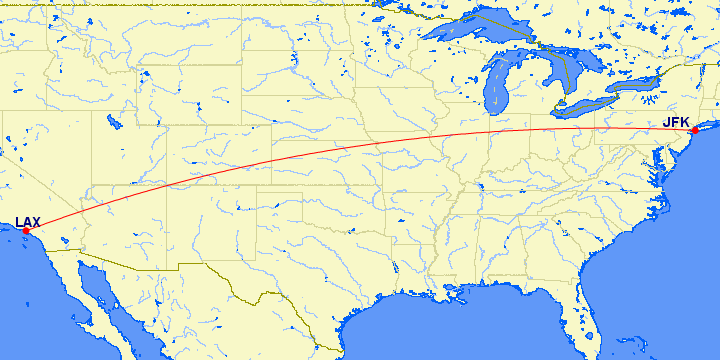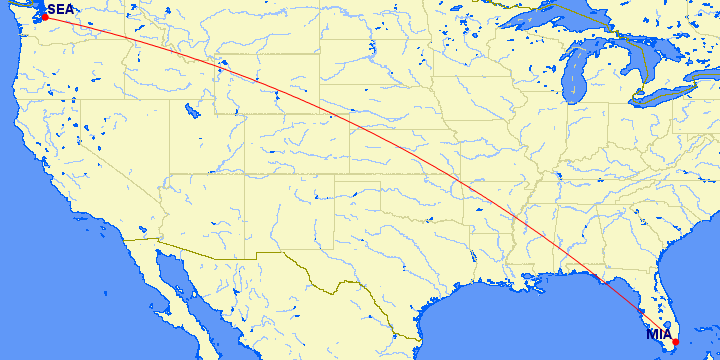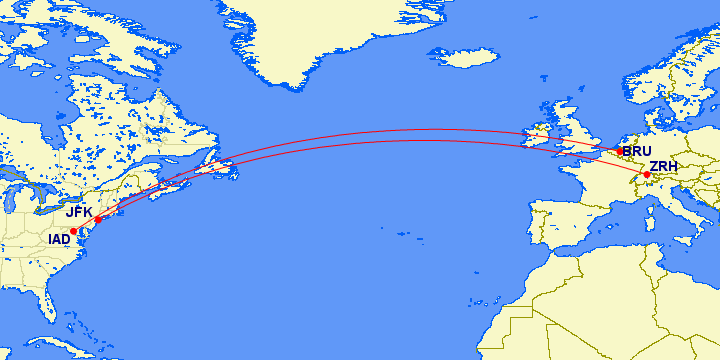In the airline world, there’s a lot of jargon that can easily confuse people when booking tickets, especially those on frequent flyer miles. It’s helpful to have a basic knowledge of the terminology used when booking a ticket, since it can give you a leg-up when traveling.
You’ll hear these three words (and their variants) a lot when traveling: Layover, Stopover and Open Jaw
For a little clarification and basic knowledge, let’s review what a one-way and round-trip are, as simple as they might be.
What is a one-way?
A one-way trip is departing one city for another city, without a return. Traditionally, one-way tickets are more expensive than round-trips, so if you can make a round-trip ticket, I would suggest doing so.
What is a round-trip?
A round-trip is departing one city for another city, and then returning via the same routing.
Here, you’ll fly from Seattle to Miami, and then Miami to Seattle (note because it is the same routing, the map does not display a separate line).
What is a Layover?
A layover is a connection in an airport, simply put. If I’m flying from Los Angeles to Denver and then connecting onto a flight to Washington Dulles 2 hours later, I have a layover in Denver airport. A layover is traditionally under 4 hours, and one does not leave the airport (however is technically under 24 hours). However, depending on connection times, it may be necessary (or possible) to leave the airport, so I wouldn’t use that as a solid definition of the term. If you’re flying into a smaller, regional airport there may be limited flights, and thus your layover may be longer than 4 hours. Let’s say you arrive from Boston to Chicago at 9am, and your connecting flight to Salt Lake City isn’t until 7p – you can leave the airport in Chicago, have a free-day trip in Chicago, and then depart on your connecting flight onward.
What is a Stopover?
A stop over is generally a connection that’s over 4 hours, or when you need to spend the night in a city while flying. If you’re flying from Miami to New York JFK, stopping in New York City for the night (and staying overnight), and then departing for London the next morning, you have a stopover in New York City. On an award ticket, a stopover may be included for free in your ticket (check with your airline). Some fares will allow a stopover – in the case of an Icelandair flight, they’ll allow you to from from the US to Europe via Iceland, where you’re allowed to stay in Iceland for up to a week at no extra charge. If you’re flying from Seattle to Dallas and then spending the night in Dallas to continue on to Washington Reagan the next morning, your ticket will most likely price as two one-way journeys – one from Seattle to Dallas, the other from Dallas to Washington Reagan. You have a stopover in Dallas.
What is an Open-Jaw?
An open jaw flight departs and returns to the same airport, however when flying the return you fly from a different airport than where you landed.
Let’s say you depart JFK for London Heathrow, spend a few days there and then take the Eurostar train to Paris to spend a few days there. For your return you fly from Paris to JFK. The “open jaw” lies between London and Paris.
An open-jaw ticket may be more expensive than a traditional round-trip ticket.
What is a Double Open-Jaw?
A double open-jaw is departing from Airport 1 to Airport 2, then returning from Airport 3 to Airport 4. Here, you have 2 open jaws – one on the outbound and one on the return.
In this example, you’ll depart from JFK to Zurich, and then return from Brussels to Washington Dulles. You will make your way on your own from Zurich to Brussels.
What are the rules?
If you’re looking for the particular rules regarding layovers, stopovers and open jaw segments, I recommend reviewing my award rules page for these popular award-redemption airlines:
Are you familiar with what a layover, stopover and open-jaw are?







 Jamie Larounis is an avid traveler, blogger and miles/points educator. Traveling well over 100,000 miles a year and staying in hotels for over 100 nights, he leverages miles, points and other deals to fly in first class cabins, and stay in 5-star hotels. The Forward Cabin shares his experiences, musings, reviews, tips, tricks, resources and industry news with you, the fellow traveler.
Jamie Larounis is an avid traveler, blogger and miles/points educator. Traveling well over 100,000 miles a year and staying in hotels for over 100 nights, he leverages miles, points and other deals to fly in first class cabins, and stay in 5-star hotels. The Forward Cabin shares his experiences, musings, reviews, tips, tricks, resources and industry news with you, the fellow traveler.
links to the airlines at the bottom of the article are not working.
And they still aren’t.
Fixed. 🙂